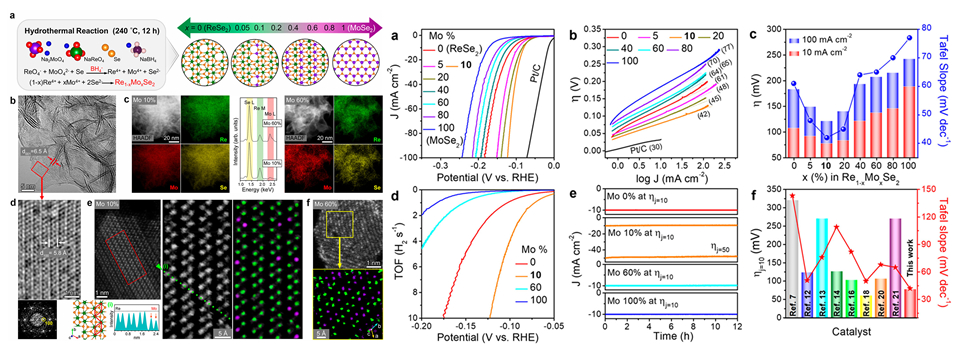- 작성일 2020.10.06
- 작성자 신소재화학과
- 조회수 4796
Phase Evolution of Re1-xMoxSe2 Alloy Nanosheets and Their Enhanced Catalytic Activity toward Hydrogen Evolution Reaction
In Hye Kwak, Ik Seon Kwon 권익선 (공동 제1저자, 박사과정), Tekalign Terfa Debela, Hafiz Ghulam Abbas, Yun Chang Park, Jaemin Seo, Jae-pyoung Ahn, Jeunghee Park (박정희 교수님),* and Hong Seok Kang*
ACS Nano 2020, 14, 11995-12005 (Impact factor: 14.588)
Abstract : Two-dimensional ReSe2 has emerged as a promising electrocatalyst for the hydrogen evolution reaction (HER), but its catalytic activity needs to be further improved. Herein, we synthesized Re1–xMoxSe2 alloy nanosheets with the whole range of x (0–100%) using a hydrothermal reaction. The phase evolved in the order of 1T″ (triclinic) → 1T′ (monoclinic) → 2H (hexagonal) upon increasing x. In the nanosheets with x = 10%, the substitutional Mo atoms tended to aggregate in the 1T″ ReSe2 phase with Se vacancies. The incorporation of the 1T′ phase makes the alloy nanosheets more metallic than the end compositions. The 10% Mo substitution significantly enhanced the electrocatalytic performance toward HER (in 0.5 M H2SO4), with a current of 10 mA cm–2 at an overpotential of 77 mV (vs RHE) and a Tafel slope of 42 mV dec–1. First-principles calculations of the three phases (1T″, 2H, and 1T′) predicted a phase transition of 1T″-2H at x ≈ 65% as well as the production of a 1T′ phase along the composition tuning, which are consistent with the experiments. At x = 12.5%, two Mo atoms prefer to form a pair along the Re4 chains. Gibbs free energy along the reaction path indicates that the best HER performance of nanosheets with 10% Mo originates from the Mo atoms that form Mo–H when there are adjacent Se vacancies.
